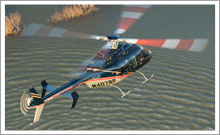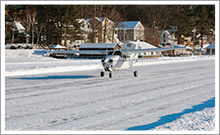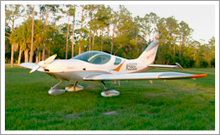| ||||
| | GA News | Safety & Proficiency | member benefits | Quiz Me | |||
Click here to view this week's custom content online today’s top storiesDonate cost of flight in wake of Haiti earthquakeAs we begin to learn more about the extent of the destruction in Haiti, hear about the staggering death toll, and see heart-breaking images coming from the area, we all want to jump in our aircraft and fly down to help. But government officials and disaster experts say that’s not the best way to help right now. AOPA has been working closely with government agencies to determine the best way pilots can contribute to the relief effort. Read a special message from AOPA President Craig Fuller >> GA relief flights bring help to HaitiMissionary Flights International joined forces with Samaritan’s Purse to begin earthquake relief flights to Haiti Jan. 13, using the MFI Douglas DC–3 aircraft. Since the airport in Port-au-Prince has been damaged, the aircraft must first go to Cap-Haïtien to clear customs. The group is asking for donations to pay for aircraft fuel, and its Web site features the latest reports on the situation in Haiti. Read more >> GA NEWSTSA surveys security practices at 3,000 GA airportsThe Transportation Security Administration this week distributed airport vulnerability assessments to 3,000 general aviation airports nationwide, focusing on those facilities with a runway of at least 2,000 feet and those near major metropolitan or prohibited areas. The survey stems from a congressional mandate, the 9/11 Commission Recommendation Act of 2007, and is not based on any “specific, credible information to suggest an imminent threat to the homeland or general aviation,” according to the TSA. “AOPA expressed concerns to the TSA early in the process of the need for the information collected by the TSA to remain confidential and not be used against an airport,” said Brittney Miculka, AOPA manager of security. “AOPA supports dedicated funding for those airports choosing to make their facilities more secure but remains strongly opposed to the mandatory requirements being unilaterally imposed.” Read more >> ADS-B goes beyond radar in the Gulf Coast Guard sounds death knell for loranThe U.S. Coast Guard gave notice Jan. 7 that it will start decommissioning the long range navigation (loran) system beginning Feb. 8. All loran stations will cease transmission by Oct. 1, according to the notice. While loran-C is not now widely used for navigation, government and independent agencies have recommended using an enhanced version of it, eLoran, as a national backup system for GPS. The termination of loran will leave the country without a single national backup system in the event of a GPS outage. Read More >> Paper pilot certificates expire in MarchYour paper pilot certificate will expire March 31. You’ll need to either go online to convert paper pilot certificates to plastic, or fill out a form and mail it to the FAA in Oklahoma City. The steps for the process are found online. Student certificates are not affected, and some nonpilot certificates are good for another three years. Read more >> GA not affected by new security procedures, for nowAs air carrier airports continue to work through the increased security measures announced by President Barack Obama last week, general aviation seems to have escaped unscathed. The security measures, put into place after the failed airline bombing attempt on Dec. 25, include strengthened terrorist watch lists, whole body imaging, and more. “AOPA is working closely with the Transportation Security Administration and Department of Homeland Security to ensure that GA is not adversely affected as the agencies work to increase airport security,” said Craig Spence, AOPA vice president of operations and international affairs. Read more >> NTSB expands reporting requirementsThe NTSB has issued a final rule that adds six reporting requirements to NTSB 830.5 (a). The reporting requirements, which will go into effect March 8, specifically address aircraft with turbine engines and glass cockpits, and also include air carriers and fixed- and rotary-wing aircraft. Read more >> Alton Bay ice runway opens New company acquires Delta Connection Academy, AerosimDelta Connection Academy and Aerosim Technologies have been acquired by Flight Training Acquisitions LLC of Burnsville, Minn., in a transaction valued at just under $50 million, FTA announced Jan. 13. The new company was formed to develop global aviation training capabilities, and to develop and market simulation-based products. The combined entity, which employs 500 people across five training centers, anticipates $40 million in sales during 2010. Read more >> Hawker Beechcraft lays off 70 workersHawker Beechcraft Corp. has issued a “Warn” notice for the pending layoff of 70 workers. Many are on the King Air assembly line while others are material handlers, The Wichita Eagle reported. The company has laid off 3,220 workers since 2008, the newspaper reported. Read more >> Piper may enter light sport arena Purdue, Able Flight training program to commencePurdue University’s Department of Aviation Technology will train two to four scholarship recipients for a sport pilot certificate through a partnership with Able Flight, a nonprofit organization for people with physical disabilities. Applications are now being accepted, and Able Flight said interviews could begin as early as February. Read more >> Flight Design USA partners with Pilot JourneyFlight Design USA, distributor of CTLS light sport aircraft, has partnered with Pilot Journey to provide its participating network of flight schools with student pilot leads. People who are interested in learning to fly can go to the Web site and get a discovery flight certificate that includes an informational DVD, a logbook, and a referral to one of the more than 400 flight schools that work with Pilot Journey. Read more >> Repair station approved for Yankee, Tiger, Cheetah Jeppesen Webinar to explain VFR+GPS chartsWith a different look and feel from the FAA’s sectional charts, Jeppesen’s VFR+GPS aeronautical charts offer an alternative that is meant to dovetail with the use of GPS for navigation. The charts are designed around common VFR flight plans and local operations, and they include features such as GPS waypoints. Pilots can find out more about the charts and how they differ from FAA sectionals in a Webinar, “Getting to know Jeppesen VFR+GPS charts,” on Friday, Jan. 22, at 4:30 p.m. Dave McLean of Jeppesen will explain the features of and technology behind the charts and answer questions in the 30-minute Webinar. Register to participate on the AOPA Webinar page. Proposed rule would expand lead monitoringA proposed revision to lead monitoring requirements would lower the threshold of lead emissions that would trigger ambient air monitoring. The Environmental Protection Agency has proposed monitoring lead levels at any site expected to emit 0.5 tons per year (tpy) of lead; current requirements are to monitor any site expected to emit 1 tpy. The air quality standards for lead remain unchanged. The agency has identified 55 airports that may need to have air quality monitors under the proposed rule, and AOPA expects that none of those airports would exceed the standards for lead. The cost of the monitoring stations will be borne by the state and local governments that are responsible for monitoring.
For daily news updates, see AOPA Online. Safety & ProficiencyGear down and locked proves fatalMistakes operating retractable gear cause one or two dozen landing accidents every year. While they’re expensive and embarrassing, the only serious injury is usually to the pilot’s pride, and most of the airplanes are repaired and flown again. There is one situation, though, where the wrong configuration is likely to be deadly, and it happens while landing with the gear down. On May 17, 2008, witnesses saw an amphibious de Havilland DHC-2 Beaver set up for what appeared to be a normal water landing on Lake Chelan, near Stehekin, Wash. Read more in this special report from the AOPA Air Safety Foundation. New quiz takes on radio communication Answers for Pilots: The tax man comethThe aviation industry has been hard hit with the economic storm over the past year. But there may be some light in the gray clouds at tax time for those who purchased aircraft to use for business purposes. The stimulus measure enacted last year, formally known as The American Recovery and Reinvestment Act of 2009, provides tax benefits for qualifying 2009 aircraft purchases and their improvements if they are used for business at least 50 percent of the time. And depending on the price of the new or used aircraft, it may be possible to deduct up to 100 percent of the cost in the year the aircraft was placed in service. Read more >> airport supportBe prepared to defend your airportAirports are easy targets of criticism from the public. They’ve been told that the airport takes up a lot of room, isn’t used by most of the local community, and doesn’t foster business because there aren’t 10-story office buildings covering every square inch of the property. Pilots know that’s simply not true and that airports afford critical services, bring millions of dollars to the local and state economies, and serve more people than the local residents. But, how do you convince the public? AOPA member Joe Frasher, director of the Greenville Downtown Airport in Greenville, S.C., stood up for his airport when the local paper last week ran an opinion piece saying the property would be better utilized as a “Central Park” for Greenville than as an airport. Read more >> Join the Airport Support Network todayEnsuring the health and vitality of your airport is up to you—incompatible development and economic and political pressures can restrict your flying. Every day, more than 2,000 Airport Support Network (ASN) volunteers work with AOPA headquarters to help save their airports, but we need more. Below is a link to a list of the airports where an ASN volunteer could make a difference.
To nominate yourself or an associate to be a volunteer, visit AOPA Online. To learn more about the Airport Support Network, visit ASN Online. blogsAOPA Now: Keeping out the coldWhen AOPA President Craig Fuller arrived at Stuttgart Municipal Airport in Arkansas Jan. 10, the cold temperatures on the ramp were more than offset by the warmth of the welcome he received. Read more >> Air Safety eJournal: Smile—you’re on camera!Flight data loggers are becoming more prevalent in the general aviation world. Will this help GA’s product liability issues, which raise the cost to all pilots and companies? Read more >> AOPA Outreach: West Coast journeyAs the newly appointed president of the AOPA Foundation, Karen Gebhart scheduled a trip to meet with pilots and members. The agenda included 12 meetings and two speeches across seven states in 10 days—the kind of trip only possible with general aviation. Follow her trip >> Fun to Fly 2010 Sweepstakes: There’s an airplane in my mall, part twoWe saw a mini-wave of light sport aircraft popping up in malls around the country this past holiday season. It’s a savvy marketing technique that capitalizes on the smaller size of the LSAs. Read more >> Hover Power: Servo transparencyPilots who learn to fly in smaller helicopters probably hear very little about servo transparency, yet this phenomenon has caused or played a role in several accidents. Read more >> member benefitsGive your insurance policies an annual inspectionThe start of a new year is the perfect time to review your insurance policies. A lot can happen in a year, and your coverage needs may have changed. You may even find that it’s time to shop around for better rates. If so, as a pilot, AOPA should be the natural first stop for you. AOPA offers great rates on everything from term life insurance and accidental death & dismemberment to aircraft and even auto insurance. Because they are AOPA certified, you won’t have to pay higher rates just for being a pilot. Make sure when you take your first flight of 2010 you can relax and enjoy the flight knowing that you’re covered by AOPA’s Insurance Services. Thousands of AOPA members got cash back in 2009. Did you? shop talkWish you had a better understanding of the regulations when talking to your mechanic or the avionics shop? Aircraft Electronics Association Vice President of Government/Industry Affairs Ric Peri answers your frequently asked questions.
Question: What is GNSS, and where can I find guidance on the installation of these systems?
Answer: Global Navigation Satellite System (GNSS) is a generic term for satellite-based navigation, including GPS, SBAS, GBAS, the Russian Global Navigation Satellite System (GLONASS), and any other satellite navigation system. GNSS sensors include those incorporating Wide Area Augmentation System (WAAS), Local Area Augmentation System (LAAS), and GLONASS. Read more >>
Submit your own question via e-mail. Quiz MeHere's a question asked by an AOPA member who contacted our aviation services staff through the AOPA Pilot Information Center. Test your knowledge.
Question: Is a 45-degree entry to the downwind required at an airport without an operating control tower?
Answer: No, there is no regulatory requirement to enter at a 45-degree angle to the runway, although it is the recommended procedure in the FAA’s Airplane Flying Handbook (page 7-3). Guidance for flying in the traffic pattern is provided by regulation 14 CFR 91.126 and 91.127. It states that each pilot of an airplane at an airport without an operating control tower must make all turns to the left unless right turns are indicated by approved light signals or visual markings. No mention is made regarding the correct entry procedure. Does this mean that a straight-in approach or an entry on the appropriate base leg is allowed? Yes, although the AOPA Air Safety Foundation does recommend using the 45-degree entry for enhanced safety whenever other aircraft are operating at the airport. For more information, read this AOPA legal briefing.
Got a question for our aviation services staff? The AOPA Pilot Information Center is a service available to all members as part of the annual dues. Call 800/872-2672, or e-mail to [email protected]. Send comments on our Quiz Me! questions to [email protected]. Picture Perfect
Aviation Events & Weather Flight Instructor Refresher ClinicsThe next AOPA Air Safety Foundation Flight Instructor Refresher Clinics are scheduled in San Antonio, Texas, and Seattle, Wash., Jan. 23 and 24; Rochester, N.Y., Portland, Ore., and Sevierville, Tenn., Jan. 30 and 31; Las Vegas, Nev., Feb. 13 and 14; Sacramento, Calif., Melbourne, Fla., Louisville, Ky., and Nashua, N.H., Feb. 20 and 21; Baton Rouge, La., Oklahoma City, Okla., Dallas, Teaxs, and Ashburn, Va., Feb. 27 and 28. For a complete schedule, see AOPA Online.
Can't make it in person? Sign up for the CFI Refresher Online. AOPA Air Safety Foundation Safety SeminarsAOPA Air Safety Foundation Safety Seminars are scheduled in San Diego, Calif., Jan. 25; Costa Mesa, Calif., Jan. 26; Ontario, Calif., Jan. 27; Burbank, Calif., Jan. 28; Little Rock, Ark., Feb. 1; Oklahoma City, Okla., Feb. 2; Wichita, Kan., Feb. 3; Ocala, Fla., Feb. 8; Tampa, Fla., Feb. 9; Melbourne, Fla., Feb 10. Topics vary—for details and a complete schedule, see AOPA Online. | Got news? Contact ePilot. Having difficulty using this service? Visit the ePilot Frequently Asked Questions now at AOPA Online or write to [email protected]. | ||
| Member Tools : Send feedback | Update member profile | Change email address | Unsubscribe | ePilot Archive ePilot Team |

 The latest deployment of a keystone technology for the NextGen Air Transportation System means that swaths of the Gulf of Mexico are no longer dead space on controllers’ radar screens. The Gulf does not have widespread radar coverage, but Automatic Dependent Surveillance-Broadcast (ADS-B) can reach areas not served by radar. Controllers began handling ADS-B-equipped traffic over the Gulf of Mexico Dec. 17, marking a step toward providing new capabilities throughout the National Airspace System. AOPA has been working with the FAA to help pilots reap the benefits of ADS-B.
The latest deployment of a keystone technology for the NextGen Air Transportation System means that swaths of the Gulf of Mexico are no longer dead space on controllers’ radar screens. The Gulf does not have widespread radar coverage, but Automatic Dependent Surveillance-Broadcast (ADS-B) can reach areas not served by radar. Controllers began handling ADS-B-equipped traffic over the Gulf of Mexico Dec. 17, marking a step toward providing new capabilities throughout the National Airspace System. AOPA has been working with the FAA to help pilots reap the benefits of ADS-B.  The ice runway at Alton Bay, N.H., opened for the 2010 season on Jan. 9—two weeks earlier than last year, thanks to colder temperatures, said Paul LaRochelle, the airport’s volunteer manager. The ice airport at the south end of Lake Winnipesaukee is the subject of a feature article, “
The ice runway at Alton Bay, N.H., opened for the 2010 season on Jan. 9—two weeks earlier than last year, thanks to colder temperatures, said Paul LaRochelle, the airport’s volunteer manager. The ice airport at the south end of Lake Winnipesaukee is the subject of a feature article, “  Rumors in Europe indicate Piper Aircraft is strongly considering a 49-percent stake in Czech Sport Aircraft and may adapt that company’s SportCruiser for the American light sport aircraft market. A spokesman for Piper said he could not confirm or deny the report by flightglobal.com, but added that Piper sometimes signs a letter of intent in order to look more closely at potential acquisitions.
Rumors in Europe indicate Piper Aircraft is strongly considering a 49-percent stake in Czech Sport Aircraft and may adapt that company’s SportCruiser for the American light sport aircraft market. A spokesman for Piper said he could not confirm or deny the report by flightglobal.com, but added that Piper sometimes signs a letter of intent in order to look more closely at potential acquisitions.  True Flight Aerospace, type holder for several Grumman American models including the Tiger, Cheetah, and Yankee, has won FAA approval to become a factory repair station. True Flight will now be able to make repairs implementing the process originally used to manufacture the airplanes without using rivets that call attention to the repair.
True Flight Aerospace, type holder for several Grumman American models including the Tiger, Cheetah, and Yankee, has won FAA approval to become a factory repair station. True Flight will now be able to make repairs implementing the process originally used to manufacture the airplanes without using rivets that call attention to the repair.  Are you making the most of your time on the airwaves?
Are you making the most of your time on the airwaves?  You have your choice of dozens of credit cards, but one stands out for the benefits it offers to pilots: the AOPA WorldPoints Rewards credit card. It’s easy to earn points with the card. One dollar spent equals one point—and when you spend money at thousands of FBOs or at certain aviation companies, you earn double points. Every time you make a purchase with the card, you send a percentage of your spending back to AOPA, all at no cost to you. That’s revenue AOPA uses to keep dues low and fight for general aviation on issues ranging from user fees to unfair regulations.
You have your choice of dozens of credit cards, but one stands out for the benefits it offers to pilots: the AOPA WorldPoints Rewards credit card. It’s easy to earn points with the card. One dollar spent equals one point—and when you spend money at thousands of FBOs or at certain aviation companies, you earn double points. Every time you make a purchase with the card, you send a percentage of your spending back to AOPA, all at no cost to you. That’s revenue AOPA uses to keep dues low and fight for general aviation on issues ranging from user fees to unfair regulations. 


